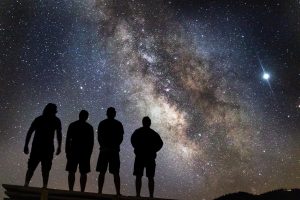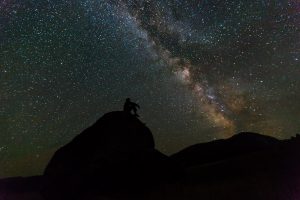
Camp traditions
Outdoor adventure
Science
Top 5 Constellations To See In The Night Sky
Written By: happycamperSummertime is here, and it’s a great time to go stargazing. Wherever you can see the night sky is a perfect place to stargaze. Grab a friend, parent, sibling, or just go outside by yourself and find a perfect place to lay down on your back to look at the beautiful night sky. Depending on where you live you may be able to see all the stars in the sky clearly or maybe just a few. Here are a few constellations that you can spot easily and will help you get started on your stargazing adventure.
Check out these top 5 constellations to see in the night sky.
Ursa Major, ‘The Great Bear’ and the Big Dipper
Though the big dipper is one of the most identifiable clusters of stars in the sky it is technically not a constellation of its own but instead is inside the constellation named Ursa Major. Also known as The Great Bear. The big dipper makes up the back end of the constellation, the hind legs, and the bear’s tail. It looks like a pot with a long handle. Ursa Major consists of eighteen major stars that you can connect to make up the constellation. While the big dipper has seven stars, that means you only have eleven more to connect. This constellation can be seen easily from April to June when all you have to do is look overhead towards the north. You’ll find the big dipper at first and from there you can connect your constellation.
Ursa Minor, ‘THE LITTLE BEAR’ and the Little Dipper
Just like the big dipper, the little dipper is a part of a constellation called Ursa Minor, or The Little Bear. To locate Ursa Minor there are multiple ways. You can either find the brightest star in the sky which is the North Star, that’ll be the little dipper’s handle and the face of Ursa Minor. Or you can find the big dipper, the outer two stars that make up the square of the dipper can be used as a guide to go directly up which will lead you to the North star/little dipper’s handle. The little dipper’s handle is the Little Bear’s tail, and the rest of the little dipper makes up the body of the bear. The easiest part with this constellation is that once you find the little dipper and its seven stars, you have no other stars to look for. The best time to see Ursa Minor is similar to Ursa Major. During April to June in the northern direction of the sky.
Orion, ‘The Hunter’
Orion is one of the largest constellations in the night sky and can be easy to spot. Orion is a huntsman that Zeus himself placed among the stars after his death from a scorpion. The stars map out the hourglass body of Orion with three of the brightest stars as Orion’s belt straight in the middle. Other stars are there to outline his sword, arm, and his bow and arrow. When looking for the constellation remember this, if you are in the northern hemisphere you would look towards the south of the sky to spot him. Or if you are in the southern hemisphere, you will find him towards the northern sky. The perfect time for Orion is during November and early December. Even though it is early in the year you can try your luck and see if you can faintly see the constellation.
Cepheus
This constellation comes from royalty, named after King Cepheus of Ethiopia. The constellation is to represent a king even though it looks similar to a stick house drawing. Five major stars outline the constellation. You’ll be able to find it easier near the Ursa Minor and Cassiopeia (the king’s wife) constellation. Locate the North Star (Polaris) that is in Ursa Minor and it is located in the upper right to the star. The constellation also has the planet Uranus inside it, you would need a telescope to locate this planet since you are unable to see it with the naked eye. November is the ideal time to see Cepheus in the sky clearly with no trouble. You can see it from August to October very faintly.
Cassiopeia
Cassiopeia is the Queen of Ethiopia, ruling next to her husband Cepheus. During her life Cassiopeia was a vain woman, the myth goes that Poseidon placed her and her husband in the sky. She is depicted as sitting on her throne, she spends circling earth half the year sky upside down as punishment. So, depending on what time of the year you are looking for this constellation it will appear to you like the letter “M” or “W” at different times. To locate this constellation, it helps to understand where the North star is, then find Cepheus and she should be on the opposite side of Cepheus away from the North star’s location. Similar to the Cepheus constellation it can be seen clearly in November, but you can also faintly see it in September, the months leading up to November.
Just remember that a constellation is not going to look exactly what it is supposed to represent. Take Cepheus for example, the constellation represents a king, and it looks like a stick figure house. After reading I now challenge you to go outside and spot all these constellations. Also, while you’re at it try and see how many more constellations you can find.
We hope this stargazing activity provides fun family time. Check out the Happy Camper Live Science Camp for other fun science activities!
Tagged:- astronomy, constellations, science camp
RELATED ARTICLES

Activities
School
Team Building Activities: Icebreakers For The First Days of School
As the new school year begins, both students and teachers may feel a mix of excitement and nervousness. Forging connections and building rapport from the get-go is essential for a positive and productive learning environment. That’s where team building activities come in – they’re not only fun but also effective in breaking down barriers and […]
School
How To Create A Back-To-School Routine
Transitioning from the carefree days of summer to the structure of school can be challenging for both children and parents alike. However, with some thoughtful planning and consistency, you can create a seamless back-to-school routine that fosters productivity, learning, and well-being. Here’s how: Start Early, Ease In Transitioning abruptly from summer vacation to a strict […]
Read More...
Campers
Map It Out: Familiarizing Yourself With Your Summer Camp
As the sun rises on the horizon and the scent of adventure fills the air, you find yourself at the threshold of a new chapter: summer camp. Whether you’re a first-time camper or a seasoned veteran, getting acquainted with your temporary home-away-from-home is crucial for a smooth and enjoyable experience. So, before you dive headfirst […]
Read More...
Activities
Campers
Breaking The Ice: Socializing Tips For The First Day Of Camp
Embarking on a new adventure at summer camp can be simultaneously thrilling and nerve-wracking. Whether you’re a first-timer or a seasoned camper, the first day can be filled with a mix of excitement and apprehension, especially when it comes to meeting new people. But fear not! With a few simple tips and tricks, you’ll be […]
Read More...
Campers
Unwritten Rules Every Summer Camper Should Know
As the sun rises higher in the sky and school winds down for the year, anticipation fills the air for the countless kids eagerly awaiting the start of summer camp. Whether you’re a seasoned camper or embarking on your very first adventure in the great outdoors, there are certain unwritten rules that every camper should […]
Read More...
HAPPY CAMPERS
How to Keep Kids Busy Year-Round
Read More...
6 Fun Games For Kids Who Love Basketball
Read More...
How To Make Walking Tacos
Read More...
Happy Camper Live: March’s Musical Camper
Read More...
categories
Activities (192)
Arts and crafts (55)
Camp stories (11)
Camp traditions (20)
Campers (87)
Cooking (33)
Education (4)
Family activities (76)
Featured camps (12)
Gift Guides (11)
Music (9)
Outdoor adventure (28)
Parents (61)
Podcast (25)
School (15)
Science (9)
Sports (32)
STEM (5)
Water sports (1)


